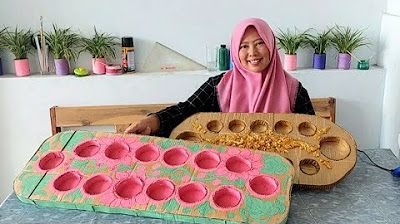DIY Texture Paste
Summary
TLDRIn this DIY tutorial, viewers learn to create a homemade texture paste using simple ingredients like baby powder, school glue, and white matte acrylic paint. The process involves mixing these components in a bowl with a spatula until well-blended. The video offers a quick solution for artists who need texture paste urgently or are hesitant to invest in store-bought options. The paste is demonstrated to work well with stencils and can be stored for future use. The tutorial is beginner-friendly, encouraging creativity without the need for professional supplies.
Takeaways
- 👶 Use baby powder as a key ingredient for making DIY texture paste.
- 🍶 Add one quarter cup of baby powder to the mixture.
- 🔨 Combine with one tablespoon of school glue for binding.
- 🥣 Use a regular mixing bowl and spatula for mixing.
- 🎨 Incorporate one tablespoon of white matte acrylic paint for color.
- 🔄 Mix the ingredients until well blended.
- 🆘 Ideal for emergencies when texture paste is needed quickly.
- 💧 Spray the mixture with water from a spray bottle for adequate control.
- 👨🎓 Suitable for beginners who are new to using texture paste.
- 🎭 Great for testing stencils and texture paste in art projects.
- 📦 Store leftovers in a plastic container for continued use over weeks.
Q & A
What is the main purpose of the video script?
-The main purpose of the video script is to provide a step-by-step guide on how to create a DIY texture paste using common household items.
What are the primary ingredients needed to make the DIY texture paste?
-The primary ingredients needed are baby powder, school glue, white matte acrylic paint, and water.
How much baby powder is required for the texture paste according to the script?
-One quarter cup of baby powder is required.
How much school glue is used in the mixture?
-One tablespoon of school glue is used.
What type of paint is recommended for the DIY texture paste?
-White matte acrylic paint is recommended.
What tool is used to mix the texture paste ingredients together?
-A spatula is used to mix the ingredients until they are well blended.
What is the purpose of spraying the mixture with water?
-Spray water is used to control the blend and achieve the desired consistency of the texture paste.
Why is this DIY texture paste a good emergency solution?
-It's a good emergency solution for when your regular texture paste has dried up and you need a quick substitute for a project.
What is the benefit of this DIY paste for beginners?
-It allows beginners to try out using texture paste in their projects without investing in high-quality, store-bought texture paste.
How can the DIY texture paste be applied to a project?
-It can be applied through a stencil onto cardstock or other surfaces, providing great results.
How long can the leftover DIY texture paste be stored for future use?
-The leftovers can be stored in a plastic container and used for a few weeks.
Outlines

This section is available to paid users only. Please upgrade to access this part.
Upgrade NowMindmap

This section is available to paid users only. Please upgrade to access this part.
Upgrade NowKeywords

This section is available to paid users only. Please upgrade to access this part.
Upgrade NowHighlights

This section is available to paid users only. Please upgrade to access this part.
Upgrade NowTranscripts

This section is available to paid users only. Please upgrade to access this part.
Upgrade NowBrowse More Related Video

2 Different Ways to Make Diy Texture Paste : Baby Powder & Baking Soda

Como fazer um PROJETOR DE CELULAR caseiro passo a passo

How to make a homemade impact grenade out of a water bottle DIY

DIY Squishy Toy Creation: Fun & Easy! 2024 12 31 #DIYSquishy #CraftingFun #StressRelief #SquishyToys

HOW TO MAKE SLIME For Beginners! NO FAIL Easy DIY Slime Recipe!

Cara membuat papan dakon, congklak dari bahan kardus bekas.
5.0 / 5 (0 votes)